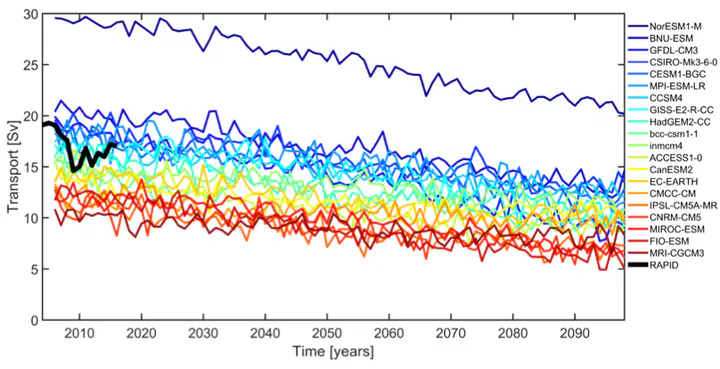Past, present, and future variations of the Atlantic Meridional Overturning Circulation
 Time series of annual mean AMOC transport represented by observations using RAPID (black line) from 2004 to 2017 and 20 CMIP5 RCP8.5 models (coloured lines) at 26.5◦ N from 2006 to 2100.
Time series of annual mean AMOC transport represented by observations using RAPID (black line) from 2004 to 2017 and 20 CMIP5 RCP8.5 models (coloured lines) at 26.5◦ N from 2006 to 2100.Abstract
The Atlantic Meridional Overturning Circulation (AMOC) is a key mechanism of the global coupled ocean-atmosphere climate system, primarily via the redistribution of heat. The northward transport of warm, salty near-surface waters from the southern hemisphere is a unique feature of the Atlantic Ocean, where paleoclimate records have associated past shutdowns of the AMOC with abrupt cooling periods, potentially lasting over a millennium. According to future projections produced by the Coupled Model Intercomparison Project Phase 5 (CMIP5), an AMOC shutdown is unlikely in the next century, although a weakening is very likely, under climate change scenarios. On the other hand, studies estimating the past and current AMOC transport struggle to reach a consensus regarding whether the AMOC has recently undergone or is undergoing a transient decline, and if so, whether it is due to current anthropogenic climate change. This is due to the complexity of the relative contribution of natural and anthropogenic forcings on AMOC variability, and limited direct observational records; the longest continuous trans-basin array being RAPID, which started in 2004. Determining how many years are required to detect a statistically significant AMOC decline is therefore the starting point of this study. From simulations of an artificial AMOC timeseries, generated based on statistical properties of the RAPID and CMIP5 AMOC, an AMOC decline is detectable after 28 to 35 years (i.e., over a decade more than current observations). This reinforces the demand for improved proxy estimates, and defines the incentive behind the other analyses in this study; to investigate potential reconstructions or indicators of the AMOC’s variability and trend in the past and the future. Using a multi-model approach to test the robustness, a proxy, that is presumably dynamically associated to the AMOC, is explored; sea surface height (SSH). The relationship between the AMOC and SSH is shown to be inconsistent across the CMIP5 models and therefore fails tore construct the AMOC’s inter annual variability or multi-decadal trend, using a 13-yeartraining period. This suggests that tidal gauge data can not be used to extend the current RAPID data in the past to identify if a long-term decline has been occurring. To further characterise the potential of an AMOC slowdown, a past and future trend probability analysis is explored using the CMIP5 database. Using 250 years of historical and future scenario data reveals that forced ensemble mean AMOC trends shift the probability of a decline outside its range of natural variability (which is estimated from the control runs), after a sustained 5-year decline or longer. This suggests that inter annual AMOC events are not significantly affected by anthropogenic forcing compared to their natural variability. Furthermore, under the ‘business-as-usual’ scenario (RCP8.5)the probability of a 20-year decline remains high (at 86.5%), and the probability of an ‘intense’ decline reaches a maximum of 55.7% (vs. 13.2% in the historical scenario);in a ‘stabilisation’ scenario (RCP4.5) the trend probability recovers its pre-industrial values by 2100. A 20-year rogue period is identified from 1995 to 2015, marked by simultaneous unique features in the AMOC and salinity transport that are not replicated over any other 20-year period within the 250-year timeseries. These features include the maximum probability and magnitude of an ‘intense’ AMOC decline, and a sustained20-year decline in subpolar salinity transport caused by internal oceanic (as opposed to atmospheric) feedbacks. This work therefore highlights the potential use of direct observations (after another decade of data), and ensemble mean numerical models tore present changes in past, present, and future natural and forced AMOC variability. Such an understanding can be used to improve future climate risk mitigation strategies and planning, with global socio-economic importance in the 21st century.